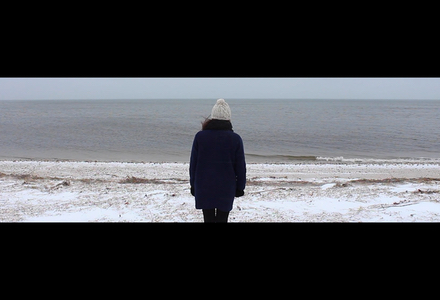Interdisciplinary Videography, Time, and Memory
By Fiona N. Cashell
If self is a location, so is love: Bearings taken, markings, cardinal points, Options, obstinacies, dug heels & distance, ..now & then, a stance.” — Seamus Heaney
“Time is infinite. It expands and it contracts. It is both still and moving. It is here and it is there. It is has no real edges. Its travels and moves beyond what we can see or fully know. Time links to place and to each of us. It connects us. Memory, is its container. I go to that place you know. The place you always knew. I know it now also. I look to the Horizon for you, but you are gone. I am looking for something else. What is it? In Horizon Lines, I explore the relationship between memory and time, and seek to understand the uncontrollable boundaries and limits that are inherent to them.”
I created Horizon Lines in 2015 as part of a site-specific MFA thesis show at Paul W. Zuccaire Gallery, Stony Brook University, New York. It is a non-narrative video piece, and was shot in various locations around Long Island, New York.

As an artist, I am intrigued by the self and the isolation in which we experience it. I tend to use environment and ideas relating to the ‘other’ to open up this isolation of self to the outside world. All explorations are created through a semiotic lens. Every place, color and action conveys a meaning or sets a tone, as does composition and pace.
Before making Horizon Lines, I was inspired by Kant’s theory of the sublime. On exploring what is incomprehensible for the mind to acknowledge or fully understand, I kept thinking about how we perceive memory and time, about the relationship between the two, and that time as an entity is elusive, incredibly expansive and in many ways, uncontrollable. When we add in environment and people, this can suddenly slow down and stabilize our sense of time; rationalizing it and bringing it into the purely physical realm, or that which is grounded in physical things and places. In contrast to this purely logical aesthetic, I felt emotion must be used as ‘proof’ that time is also non-linear, therefore, circling back to the initial thought that time is uncontrollable and that perhaps memory as the initiator for emotion is essentially fallible, and subject to change.
In this piece, and indeed in many of my other works, my aim was to create a cinematic and somewhat meditative space in which the viewer could sense the expansiveness of the minds eye. The experience of self, while it is largely internalized, is reliant upon its environment and is greatly impacted by it.
In constructing the shots, I centered conceptual considerations on the connection between the person I was seeking and my own attachments. I visited the places in which I felt their presence, and used memory as a vehicle for sense and feeling, suggesting to my audience that it is bound by nothing.
Scenes go back and forth between the protagonists isolation and the projection of self she feels at play in everything around her. She longs to break down the expansiveness of distance she feels between person and place, memory and time. She soon realizes that what seems still is always moving.
In the end, there is no fundamental understanding or resolve to be had, just a greater sense of what we can’t quantify, and an enigmatic rejoice in what it is to feel.


Fiona Naomi Cashell is an emerging lens-based interdisciplinary artist, exploring the boundaries and artistic use of contemporary photography, video, sound, painting, and drawing. Through experimentation in the studio and beyond, she questions, tests, and investigates the experiential and cognitive nature of form and color, the role of light and material, the still versus moving image dichotomy, hybrid print techniques, interdisciplinary practice, collaboration, and site-specific art making. Work created is usually situational in context and site-specific, utilizing the immediate environment and incorporating current life events in order to generate content that emphasizes a time-based and personal orientation. Current research within her practice includes theories relating to philosophy, psychology and cognitive aesthetics, with a specific focus on phenomenology, otherness, sense, consciousness and cognition.

